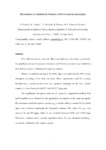Biosorption of Cadmium by Biomass of Brown Marine Macroalgae

View/
Use this link to cite
http://hdl.handle.net/2183/176Collections
- Investigación (FCIE) [1227]
Metadata
Show full item recordTitle
Biosorption of Cadmium by Biomass of Brown Marine MacroalgaeAuthor(s)
Date
2005-11-07Citation
Bioresource Technology, 2005, 96, p.1796-1803
Abstract
[Abstrac] Five different brown seaweeds, Bifurcaria bifurcata, Saccorhiza polyschides, Ascophyllum nodosum, Laminaria ochroleuca and Pelvetia caniculata were studied for their ability to remove cadmium from aqueous solution. Kinetic of cadmium adsorption by all the algae was relatively fast, 90% of total adsorption occurring in less than one hour. These experiments could be accuracy described by a pseudo-second order rate equation, obtaining for the rate constant sorption, k, values between 1.66·10-3 and 9.92·10-3 g/mg·min. The equilibrium adsorption isotherms of Langmuir, Langmuir-Freundlich, Tóth and Freundlich were obtained for the quantitative description of the cadmium uptake. The maximum metal biosorption capacity (qmax) and the affinity constant (b) for all the algae were evaluated employing the Langmuir isotherm. The values for qmax were between 64 and 95 mg/g, whiles b was included between 0.036 and 0.094 L/mg. Moreover, a dimensionless constant separation factor, Rs, was calculated founding a favourable condition for the sorption system.
1
The effect of pH on biosorption was studied at values ranging from 1 to 6, demonstrating the importance of this parameter for the removal of cadmium. Equilibrium studies were carried out at pH 4.5. Acid-base properties of algae were studied by potentiometry, leading to pK values (from 3.54 to 3.98), which are comparable with typical values associated to the ionization of carboxyl groups of alginates. Furthermore, the total number of these acid groups was estimated.
Keywords
Biosorption
Cadmium
Marine macroalgae
Kinetics
Equilibrium
Acid base properties
Cadmium
Marine macroalgae
Kinetics
Equilibrium
Acid base properties
Editor version
ISSN
0960-8524





